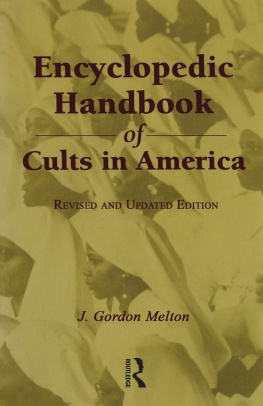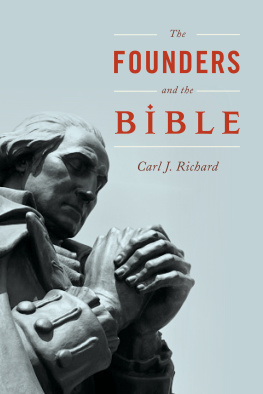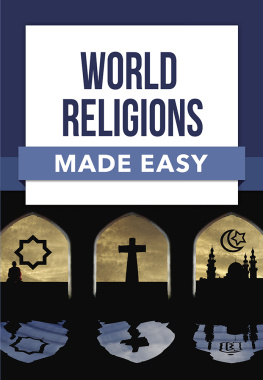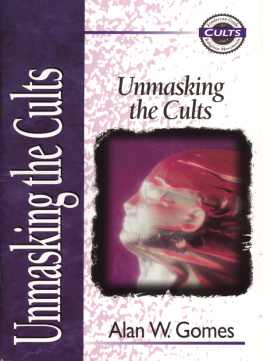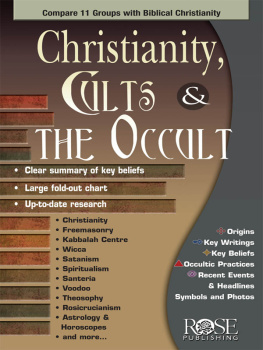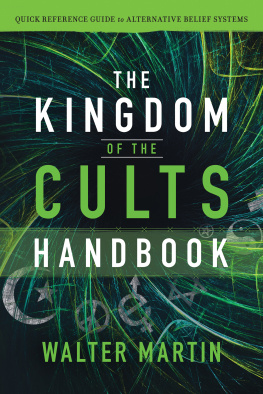J. Gordon Melton - Encyclopedic Handbook of Cults in America
Here you can read online J. Gordon Melton - Encyclopedic Handbook of Cults in America full text of the book (entire story) in english for free. Download pdf and epub, get meaning, cover and reviews about this ebook. year: 2014, publisher: Taylor and Francis, genre: Religion. Description of the work, (preface) as well as reviews are available. Best literature library LitArk.com created for fans of good reading and offers a wide selection of genres:
Romance novel
Science fiction
Adventure
Detective
Science
History
Home and family
Prose
Art
Politics
Computer
Non-fiction
Religion
Business
Children
Humor
Choose a favorite category and find really read worthwhile books. Enjoy immersion in the world of imagination, feel the emotions of the characters or learn something new for yourself, make an fascinating discovery.
- Book:Encyclopedic Handbook of Cults in America
- Author:
- Publisher:Taylor and Francis
- Genre:
- Year:2014
- Rating:4 / 5
- Favourites:Add to favourites
- Your mark:
- 80
- 1
- 2
- 3
- 4
- 5
Encyclopedic Handbook of Cults in America: summary, description and annotation
We offer to read an annotation, description, summary or preface (depends on what the author of the book "Encyclopedic Handbook of Cults in America" wrote himself). If you haven't found the necessary information about the book — write in the comments, we will try to find it.
Encyclopedic Handbook of Cults in America — read online for free the complete book (whole text) full work
Below is the text of the book, divided by pages. System saving the place of the last page read, allows you to conveniently read the book "Encyclopedic Handbook of Cults in America" online for free, without having to search again every time where you left off. Put a bookmark, and you can go to the page where you finished reading at any time.
Font size:
Interval:
Bookmark:

by
J. Gordon Melton
by
J. Gordon Melton

First published 1992 by Garland Publishing, Inc.
This edition published 2013 by Routledge
Routledge
Taylor & Francis Group
605 Third Avenue, New York, NY 10017
New York, NY 10017
Routledge
Taylor & Francis Group
2 Park Square, Milton Park
Abingdon, Oxon OX14 4RN
Routledge is an imprint of the Taylor & Francis Group, an informa business
1992 J. Gordon Melton
All rights reserved
This is a revised and updated edition of Encyclopedic Handbook of Cults in America by J. Gordon Melton (Garland Publishing, 1986).
Library of Congress Cataloging-in-Publication Data
Melton, J. Gordon.
Encyclopedic handbook of cults in America / by J. Gordon Melton revised and updated ed.
p. cm. (Religious information systems series; vol. 7)
(Garland reference library of social science; v. 797)
Includes index.
ISBN 0-8153-0502-8. ISBN 0-8153-1140-0 (pbk.)
1. CultsUnited States. 2. SectsUnited States. 3. United StatesReligion. 4. CultsControversial literatureHistory and criticism. I. Title. II. Series. III. Series: Garland reference library of social science; v. 797.
BL2525.M45 1992
291'.0973dc20
92-11540
CIP
DOI: 10.4324/9781315048154
TO THE FIRST EDITION
There has been a growing need in the past several years for a concise summary of the most accurate information available on the more important of the alternative and nonconventional religious movements. As the cult wars of the 1970s have waned, the groups which had been the object of so much controversy remain. They have settled into the American religious landscape and show every sign of staying in place for the foreseeable future. For that reason alone, a guide to the more prominent of the 500 plus alternatives to the more familiar churches is necessary. The controversy which surrounds each of the groups considered here reinforces that observation.
The volume is divided into six sections. Section I surveys the broad range of issues surrounding the topic of cults, the popular label given alternative religion, and attempts to summarize the present state of knowledge. Because of the nature of the controversies concerning the cults, a number of false stereotypes exist about them. These are discussed in the appropriate succeeding chapters.
Section II discusses approximately twenty of the older, more established nonconventional religions, all of which have their origin in the nineteenth or early twentieth century. Out of the many which could have been discussed, those chosen were selected primarily on the basis of size (a major criterion of success) and the presence of continuing controversy about them. As a whole, their main opponents have been the evangelical Christian counter-cult ministries who oppose these groups for deviating in their teachings from orthodox Christianity. Several of these groups, among them the I AM Activity and the Universal Peace Mission Movement, were selected as examples of still-vital movements which were at one time widely discussed but which have in recent years been forgotten.
Section III gives an in-depth treatment of the prominent and growing New Age Movement, about which very little descriptive literature exists. It has been a difficult movement to grasp because it is so decentralized and diverse. To aid readers in further research and understanding, a lengthy bibliography of New Age literature has been appended to the description.
Section IV is the heart of the volume. It discusses sixteen of the most significant new religions which have either emerged in America or been transported to its shores in the past few decades. For each group, as with the older cults, an attempt has been made to highlight basic data about the groups history, founder(s), beliefs and practices, and organization. An estimate of current strength is given and the recent controversies summarized.
Section V will be especially helpful to the neophyte to the cult controversies. It discusses the two main groups opposing nonconventional religions. The secular anti-cult movement appeared in the 1970s and has concentrated its attack primarily on the groups discussed in Section IV. Christian ministries, responding from an Evangelical perspective to the growing pluralism in American society, appeared earlier, after World War II. They speak to the issue of cults from a Christian theological stance. Up to now there has been little effort to compile the story of the development of this particular mission thrust and to see it as a distinct evangelical enterprise. In its developing years, the Christian ministries directed most of their energy to the older and larger groups, such as the Jehovahs Witnesses and the Mormons. Recently there has been a shift of considerable time and effort to the newer Eastern religions. In the final section a single important issue is raised for more substantial consideration: violence. The section discusses violence inflicted upon cult groups and members as well as that initiated within a cult body. Suggestions on reducing and eliminating cult-related violence are offered.
This book is by no means the final word. A separate chapter on legal matters, from lawsuits to nonviolent crime, should possibly have been included, but not feeling sufficiently versed to offer an adequate survey, I limited my remarks to those several cases discussed in the chapters on the specific group involved. It is my hope that such a survey can be accomplished in the near future.
The information contained in these chapters is as accurate as possible. Members and leaders of the groups discussed have been contacted, as have their critics. It has not always been possible to reach an agreement on matters of fact, and I am quite sure that people will disagree with interpretations placed upon data. I welcome additional information that will correct any errors in this volume or provide important but overlooked information which should be taken into account in making an informed evaluation.
I have been studying nonconventional religion in America for over twenty years and writing about it for over a decade. I have worked as a professional church historian while wearing a second hat as a United Methodist minister with a distinct commitment to a conservative evangelical Wesleyan Christian faith. As a youth, I became both concerned about and fascinated by the multitudinous splinters of Christianity and then intrigued with the growing presence of so many non-Christian groups. During the 1960s, while still in seminary, I became convinced that the heterodox Christian groups and the non-Christian groups represented a phenomenon which was inadequately understood by my colleagues in church history and which was destined soon to play a much more important role in American life than any had anticipated. The cult wars and the spread of Asian religion in America in the last decade have proved my premonition correct.
However, in the 1960s, I set out to document and build a library of materials about the smaller and more nonconventional religions in America, and in 1969, with the aid of some fellow students at Garrett Theological Seminary, I founded the Institute for the Study of American Religion as an independent research facility concerned with Americas less-documented religions. It began and has continued as a scholarly pursuit, and other researchers around the country have contributed their time and talent to make it the success it has been. It has deliberately remained neutral in the cult wars, though I as its director have occasionally fought a battle or two. Furthermore, it was not turned into a ministry with a prime task of evangelizing non-Christians, though this has on occasion been a by-product of counseling individuals who turned to the institute staff for assistance. Rather, the institutes role has been one of providing a resource for the church and the public from which both could draw accurate information upon which policy decisions about ministry to and relationships with the new religions could be made.
Next pageFont size:
Interval:
Bookmark:
Similar books «Encyclopedic Handbook of Cults in America»
Look at similar books to Encyclopedic Handbook of Cults in America. We have selected literature similar in name and meaning in the hope of providing readers with more options to find new, interesting, not yet read works.
Discussion, reviews of the book Encyclopedic Handbook of Cults in America and just readers' own opinions. Leave your comments, write what you think about the work, its meaning or the main characters. Specify what exactly you liked and what you didn't like, and why you think so.

